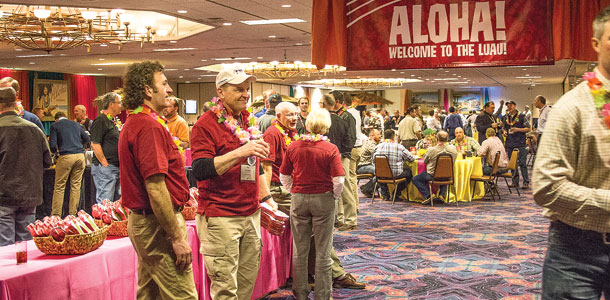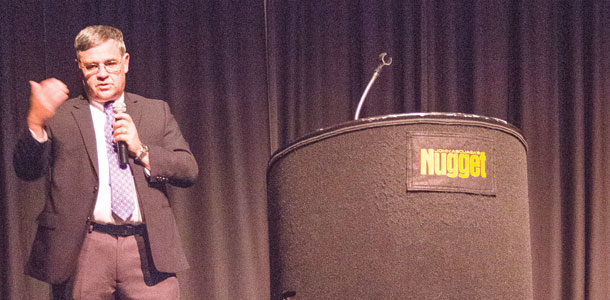Two founding members of the Western Dairy Management Conference were honored in March with memorial lectures during the 12th biennial gathering of the conference in Reno, Nevada. More than 1,600 researchers, educators, allied industry and dairy producers from across the country participated in the three-day educational event for large-herd dairies.
In memoriam
Since the last gathering of the conference, conference founders and committee members John F. Smith and Don Bath both passed away. Beginning with this year’s event, organizers agreed to honor the passing of former committee members with a one-time memorial lecture that would bear their name and be given at the next conference following their death.
Joe Horner of Kansas State University gave the memorial lecture honoring John F. Smith to open the conference. Seth Hoyt of The Hoyt Report spoke during the Don Bath Memorial Lecture.
“John was in his element when doing heat-stress research work,” Horner said of the former New Mexico State University, Kansas State University and most recently University of Arizona educator.

Horner said future heat-stress abatement would require more “finesse” and would need further research to determine the optimum amount of natural resources (water and energy) to be used in cow cooling.
To further improve water savings, Horner said, cooling strategies need to be tied to and triggered by specific thresholds on the temperature-humidity index (THI).
As much as 30 to 50 percent of the water used for cooling could be saved if this were the case. However, he also said the reliability of on-farm equipment to measure relative humidity, a critical piece of the THI formula, must improve before these savings could ever be realized.
Horner explained that the technology to save more water, such as motion-triggered or infrared-sensitive nozzles, is feasible. Yet with at best 2 million of the nozzles needed industry-wide and at about $60 a piece, owners of the patents for the technology understandably don’t see a viable dairy market for producing them right now, he said.
Horner acknowledged that current trends in heat abatement mostly focus on tweaking proven strategies rather than developing new technology.
“Technologies available for reducing water consumption are currently lacking,” he concluded.
Observationsduring the conference
Here’s some of the one-liners that were instant take-home messages from the conference:
- During his Don Bath Memorial Lecture, Hoyt predicted that alfalfa production in California will be lower in 2015, meaning that California dairies will be importing hay from other western states to make up the difference. He also predicted that lower milk prices will lead to less aggressive early season buying for forages than was seen in 2014.
- Veterinarian Dan Grooms with Michigan State University reminded producers that December 2016 is a month to circle on their calendar. That’s when medicated feeds, such as medicated milk replacers, will no longer be available “over-the-counter” and will require a veterinary feed directive, or prescription, to be fed.
What this may mean in practice is that they will only be permitted to be fed short-term as a treatment for scours and not consistently as a preventative measure for the condition.
- Tom Suber, CEO of the U.S. Dairy Export Council, said one out of every seven days’ worth of milk production in the U.S. (about 15 percent) ends up as an exported product. He said that amount is “too small to go away without noticing but not big enough to command attention in the national economy.”
- Peter Robinson of the University of California – Davis reported new research about silage shrink. He said total silage shrink on well-managed silage piles in their study was 8 percent on a wet basis or 3 percent on an actual dry weight basis (corrected for volatile particles lost during fermentation).
The results showed the amount of volatile emissions to the atmosphere were lower than the current regulations for California producers. The greatest shrink occurred inside the pile prior to opening it up for feeding and not at the silage face during feedout, as some might believe, Robinson said.
- Randy Shaver of the University of Wisconsin concluded his presentation on feeding corn shredlage to dairy cows with a hint at the “next big thing.” He said a few early adopters are installing novel intermeshing disk processors on their choppers to process corn silage. Shaver only knew of their existence but did not have any research on the new technique.
- Bill Weiss of Ohio State University offered producers several tips when it comes to monitoring their TMRs and the nutritional composition of their purchased ingredients. Weiss said he would prioritize dollars for testing feed variation toward wetter feeds (i.e., silage, haylage, etc.).
Drier feeds, including off-farm commodity purchases (i.e., cottonseed, soybean meal, etc.), are less likely to be variable when sampled, Weiss said. When taking a grab-sample of silage, Weiss encouraged producers to take an underhand sample or use a scoop rather than an overhand sample. An overhand sample, he said, is more likely to lose some of the finer particles between the pile and the sample bag.
- A panel of producers using genomics for herd improvement all agreed that before you consider using genomics in your herd, you should first be comfortable paying a premium to use the best semen available.
“Use good bulls before you worry about genomics,” suggested Jonathan Lamb of Lamb Farms in Oakfield, New York. Jon Andersen of Double A Dairy in Jerome, Idaho, added: “IVF and flushing cows isn’t necessary to make good genetic progress in your herd. It’s something you can add on later.”
- Tim Hunt of Rabobank pointed out that if milk growth in the EU does occur after its milk quotas are removed, it will “be in the hands of co-ops adept at placing product off-shore,” meaning more competition for U.S. dairy exports.
He also said he believes China will be “reasonably comfortable” in the long term importing 10 to 30 percent of its dairy product needs, ensuring the Chinese marketplace will be a growing market for global dairy competition for years to come.
The Western Dairy Management Conference will next be held in 2017. PD
PHOTOS
TOP: Joe Horner gives the John F. Smith Memorial Lecture to open the 2015 Western Dairy Management Conference in Reno, Nevada, in March. Smith and Don Bath, who passed away since the last conference, were both honored with memorial lectures.
MIDDLE, BOTTOM: The conference’s traditional opening night reception had a luau theme and was sponsored by Mycogen Seeds. The company gave away T-shirts compressed into the shape of a hula girl, shown above.Photos by Walt Cooley.

Walt Cooley
Editor
Progressive Dairyman






